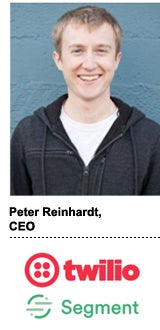The $3.2 billion price tag on cloud communications platform Twilio’s acquisition of CDP Segment in October was sexy.
But the data problem Segment aims to solve, although vitally important, is often considered less so, says Peter Reinhardt, co-founder of Segment and CEO of a new entity called Twilio-Segment that’s working on building a platform to incorporate data and communications.
“If you ask CMOs whether their top priority is getting their data extremely organized, they’d probably say, ‘What are you talking about?’” Reinhardt said.
Rather than audience creation and customer journey orchestration, Segment’s technology is primarily focused on driving data quality to build what Reinhardt calls a “good data foundation.”
“The UI, machine learning algorithms – that all needs to be there, but that’s not the hard problem,” he said. “The hard problem is getting the right data to the right spot.”
AdExchanger caught up with Reinhardt for a few hot takes.
 On what Twilio and Segment are building together.
On what Twilio and Segment are building together.
“Bringing customer data into communications channels drives your ability to engage with customers in intelligent ways, and that goes in both directions. If you can get data out of your communications channels, you can augment customer profiles, and you can use the data in customer profiles to make sure that your communications are more intelligent when you reach out to customers.
“There’s still a lot that we’re going to announce, but one concrete example of something that customers can do today is to use the Twilio Event Streams API to get data out of Twilio’s APIs for voice, SMS and email and make it flow into Segment to enrich profiles in the CDP.”
On what Twilio-Segment sees as its differentiator.
“We’re trying to empower developers to build on top of infrastructure as easily as possible.
“Coming at this challenge from an infrastructure perspective is unusual in the martech space. But Jeff [Lawson, Twilio’s CEO] has something he often says about prepackaged software, which is that if you’re buying something that anyone can buy off the shelf, it’s not going to be differentiated.”
On what the combination of Twilio and Segment means for the CDP space writ large.
“Hopefully, we’ll see a broader shift in the market toward a focus on infrastructure and the need to provide good, clean data.
“A lot of the CDP market today is made up of vendors that put the cart before the horse, by which I mean they focused on the activation layer and neglected what I’d argue is the real value of being a CDP. But what is a CDP spelled out? “Customer data platform.” And what does that mean? It should mean accurate and complete data about a customer.
“The current market of CDPs is also, broadly speaking, too dominated by the big martech SaaS providers. But a one-size-fits-all solution is bad for any business that wants to differentiate itself based on customer engagement and the customer experience.”
On what driving customer engagement should mean in practice.
“The way marketing tools get sold today is based on specific examples of campaigns you can run that you couldn’t run before and the ROI they should be able to deliver. The challenge there is that it leads to fragmentation. People end up having one tool they use for this channel and another they use for that channel.
“And the place where it all falls apart is the data layer, because that’s the heaviest lift.
“We have a bunch of APIs on the Twilio side that let you take action with the customer. The question is, what’s the right way to do that? In the real world, it’s a clerk in a store asking questions. Online, it’s about bringing data into the equation rather than using rote or simple triggers and rules to determine how companies interact with customers.”
On whether the ongoing pandemic created any tailwinds for the business.
“There’s been a bit of a tailwind broadly. At the end of 2019, we were processing 500 billion API calls a month and by the end of last year, we were processing 1 trillion a month.
“But more so it’s just been volatile starting with the chaos of last March and then the election. During periods of extreme volatility, people aren’t always eager to make significant purchases and re-architect how their data flows, even though there’s been growing pressure to digitize as fast as possible.”
This interview has been edited and condensed.















